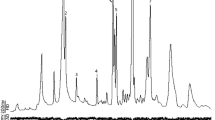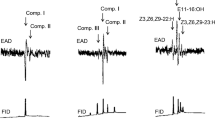Abstract
Eggs ofPieris rapae (L.) contain a water- and methanol-soluble oviposition-deterring pheromone (ODP) that is avoided by ovipositing females offered treated and untreated cabbage leaves in a choice situation. Water extracts of female accessory glands also deter oviposition. Egg washes and gland extracts stimulate a contact chemoreceptor in sensilla on the fore tarsi. Electroantennogram (EAG) recordings show that antennal receptors respond to volatiles from conspecific eggs, but not to volatiles from eggs ofMamestra brassicae. No differences were detected between North American and European insects with regard to production and perception of ODP. These results differ from conclusions in the literature based upon field observations. It is concluded that this discrepancy in due to methodological differences.
Similar content being viewed by others
References
Averill, A.L., andProkopy, R.J. 1989. Distribution patterns ofRhagoletis pomonella (Diptera: Tephritidae) eggs in hawthorn.Ann. Entomal. Soc. Am. 82:38–44.
Behan, M., andSchoonhoven, L.M. 1978. Chemoreception of an oviposition deterrent associated with eggs inPieris brassicae.Entomol. Exp. Appl. 24:163–179.
Crnjar, R.M., andProkopy, R.J. 1982. Morphological and electrophysiological mapping of tarsal chemoreceptors of oviposition deterring pheromone inRhagoletis pomonella flies.J. Insect Physiol. 28:393–400.
Drongelen, W. van, 1979. Contact chemoreception of host plant specific chemicals in larvae of variousYponomeuta species (Lepidoptera).J. Comp. Physiol. 134:265–279.
Elton, C.S. 1958. The Ecology of Invasions by Animals and Plants. Methuen, London.
Harcourt, D.G. 1961. Spatial pattern of the imported cabbage worm,Pieris rapae (L.)(Lepid.: Pieridae), on cultivated cruciferae.Can. Entomol. 93:945–951.
Hodgson, E.S., Lettvin, J.Y., andRoeder, K.D. 1955. Physiology of a primary chemoreceptor unit.Science 122:417–418.
Hurter, J., Boller, E.F., Städler, E. Blattmann, B., Buser, H.R., Bosshard, N.U., Damm, L., Kozlowski, M.W., Schöni, R., Raschdorf, F., Dahinden, R., Schlump, E., Fritz, H., Richter, W.J., andSchreiber, J. 1987. Oviposition-deterring pheromone inRhagoletis ceras L.: Purification and identification of the chemical constitution.Experientia 43:151–164.
Ives, P.M. 1978. How discriminating are cabbage butterflies?Aust. J. Ecol. 3:261–276.
Jones, R.E. 1977. Movement patterns and egg distributions in cabbage butterflies.J. Anim. Ecol. 46:195–212.
Kellogg, T. 1985. Egg dispersion patterns and egg avoidance behavior in the butterflyPieris sisymbrii Bdv. (Pieridae).J. Lepid. Soc. 39:268–275.
Klijnstra, J.W. 1985a. Interspecific egg load assessment of host plants byPieris rapae butterflies.Entomol. Exp. Appl. 38:227–231.
Klijnstra, J.W. 1985b. Oviposition behaviour as influenced by the oviposition deterring pheromone in the large white butterfly,Pieris brassicae. PhD thesis. Wageningen Agricultural University, Wageningen.
Klijnstra, J.W., andSchoonhoven, L.M. 1987. Effectiveness and persistence of the oviposition deterring pheromone ofPieris brassicae in the field.Entomol. Exp. Appl. 45:227–235.
Kobayashi, S. 1965. Influence of parental density on the distribution pattern of eggs in the common cabbage butterflyPieris rapae crucivora.Res. Popul. Ecol. 7:109–117.
Ma, W.-C., andSchoonhoven, L.M. 1973. Tarsal contact chemosensory hairs of the large white butterflyPieris brassicae and their possible role in oviposition behaviour.Entomol. Exp. Appl. 16:343–357.
Roitberg, B.D. andProkopy, R.J. 1987. Insects that mark host plants. An ecological, evolutionary perspective on host-marking chemicals.BioScience 37:400–406.
Roitberg, B.D., Cairl, R.S., andProkopy. R.J. 1984. Oviposition deterring pheromone influences dispersal distance in tephritid fruit flies.Entomol. Exp. Appl. 35:217–220.
Root, R.B., andKareiva, P.M. 1984. The search for resources by cabbage butterflies (Pieris rapae): ecological consequences and adaptive significance of Markovian movements in a patchy environment.Ecology 65:147–165.
Rothschild, M., andSchoonhoven, L.M. 1977. Assessment of egg-load byPieris brassicae (Lepidoptera: Pieridae).Nature 266:352–355.
Schoonhoven, L.M.,Beerling, E.A.M.,Klijnstra, J.W., andVugt, Y. van. 1990. Two related butterfly species avoid oviposition near each other's eggs.Experientia 46 (in press).
Scudder, S.H. 1887. The introduction and spread ofPieris rapae in North America 1860–1886. With a map.Mem. Boston Soc. Nat. Hist. 4:53–69.
Shapiro, A.M. 1980. Egg-load assessment and carry over diapause inAnthocaris (Pieridae).J. Lepid. Soc. 34:307–315.
Singer, M.C. 1986. The definition and measurement of oviposition preference in plant-feeding insects, pp. 65–94,in J.R. Miller and T.A. Miller (eds.). Insect-Plant Interactions. Springer-Verlag, New York.
Traynier, R.M.M. 1979. Long-term changes in the oviposition behaviour of the cabbage butterfly,Pieris rapae, induced by contact with plants.Physiol. Entomol. 4:87–96.
Wiklund, C., andÅhrberg. 1978. Host plants, nectar source plants, and habitat selection of males and females ofAnthocaris cardamines (Lepidoptera).Oikos 31:169–183.
Author information
Authors and Affiliations
Rights and permissions
About this article
Cite this article
Schoonhoven, L.M., Beerling, E.A.M., Braaksma, R. et al. Does the imported cabbageworm,Pieris rapae, use an oviposition deterring pheromone?. J Chem Ecol 16, 1649–1655 (1990). https://doi.org/10.1007/BF01014097
Received:
Accepted:
Issue Date:
DOI: https://doi.org/10.1007/BF01014097




